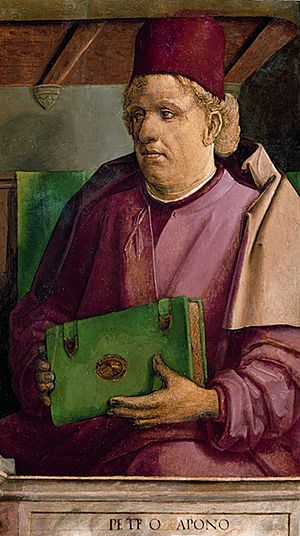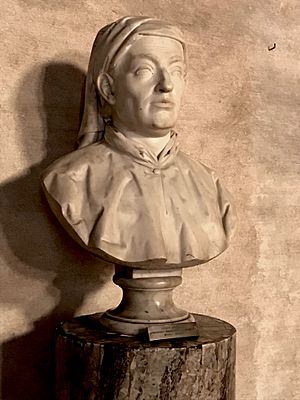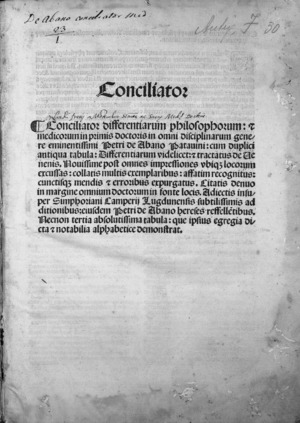Pietro d'Abano facts for kids
Quick facts for kids
Pietro d'Abano
|
|
|---|---|
 |
|
| Born | c. 1257 Abano Terme
|
| Died | c. 1315 Rome
|
| Nationality | Italian |
| Occupation | Philosopher Astrologer Physician |
Pietro d'Abano (born around 1257, died around 1316) was an Italian thinker, astrologer, and a professor of medicine. He was born in a town now called Abano Terme, which is where he got his name. Pietro became famous for writing a book called Conciliator Differentiarum, quae inter Philosophos et Medicos Versantur. Later in his life, he was accused of heresy (beliefs against official church teachings) and atheism (not believing in God). He faced a special court called the Inquisition. Pietro died in prison in 1315 or 1316 before his trial was finished.
Contents
Pietro d'Abano's Life and Studies

Pietro d'Abano spent some time living in Greece. Then, between 1270 and 1290, he studied for many years in Constantinople. Around 1300, he moved to Paris, France. There, he earned degrees as a doctor in both philosophy and medicine. He was very good at his job as a doctor, but his fees were quite high! In Paris, people called him "the Great Lombard."
Later, Pietro settled in Padua, Italy, where he became a well-known physician. In Padua, he became friends with an older scholar named Paolo Tosetti. Pietro was also an astrologer, someone who studies how stars and planets might affect people's lives. Because of his skills, some people accused him of practicing magic. They even claimed he could make money return to his purse with the help of the devil, or that he had a special "philosopher's stone" that could turn metal into gold. These were just rumors, though.
Pietro studied many deep and hidden subjects. He wrote about physiognomy (judging character from faces), geomancy (divination using patterns on the ground), and palmistry (reading palms). He also studied philosophy, physics, and astrology. These studies helped him a lot. His work in philosophy and physics made him known to the popes of his time and earned him respect among other scholars.
His knowledge of astrology was very impressive. You can see this from:
- The special astronomical pictures he had painted in a large hall at the palace in Padua.
- His translations of books by the famous scholar Abraham ibn Ezra.
- His own books about "critical days" (days thought to be important based on astrology).
- His work to improve astronomy.
- The praise he received from the well-known mathematician Regiomontanus, who spoke about Pietro's astrology skills in Padua.
Pietro d'Abano's Writings
In his books, Pietro d'Abano explained and supported the medical and philosophical ideas of Islamic scholars like Averroes and Avicenna. His two most famous books are Conciliator differentiarum quae inter philosophos et medicos versantur and De venenis eorumque remediis. Many copies of these books still exist today, and they were printed many times from the late 1400s to the 1500s.
The Conciliator tried to explain how medical ideas and the natural philosophy of Aristotle could fit together, even if they seemed to disagree. This book was considered very important until the 1500s.
Another famous book, a grimoire (a book of magic spells), called the Heptameron, is often said to have been written by Pietro d'Abano, even though it doesn't have his name on it. The Heptameron is a short book with instructions for magic rituals. It focuses on calling upon specific angels for each of the seven days of the week. Pietro is also believed to have written De venenis eorumque remediis, which discussed Arab ideas about superstitions, poisons, and diseases.
The Inquisition and Pietro d'Abano
Pietro d'Abano was put on trial twice by the Inquisition. The Inquisition was a special court of the Catholic Church that judged people accused of having beliefs that went against the Church's teachings. The first time, he was found innocent. However, he died in prison before his second trial was finished.
Even though he had died, the court found him guilty. They ordered that his body be dug up and burned. But a friend had secretly moved his body, so the Inquisition had to burn a dummy (a figure made of straw) that looked like him instead. This public burning of a dummy happened in Padua.
Some people believed Pietro was the greatest magician of his time. They thought he had seven spirits trapped in crystals that helped him learn everything. They also believed he could make money return to his pocket.
It is thought that the Inquisition didn't sentence Pietro to death just for magic. They were also concerned because he tried to explain natural events using the influence of stars and planets, rather than saying they were caused by angels or demons. This was seen as a challenge to the Church's teachings about spiritual beings. So, it was more about heresy (disagreeing with religious doctrine) than just magic that led to his persecution.
After his death, Pietro's friends secretly moved his body from his grave to keep it safe from the Inquisition. He was moved several times and finally buried in St. Augustin's Church without a special marker. Pietro d'Abano died around 1316, when he was about 66 years old.
See also
 In Spanish: Pietro d'Abano para niños
In Spanish: Pietro d'Abano para niños



